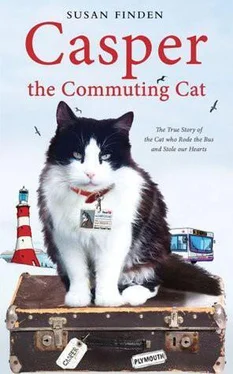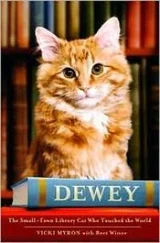Casper had a certainty about him that made people accept him. If he was sitting on a chair in a doctor’s waiting room, then perhaps that was where he was meant to be. It was as if he could persuade people to give him what he wanted just by being there. He was a calm cat who never bothered humans. He liked their company but waited for them to approach him a lot of the time. He wasn’t one of those cats who constantly pushed and rubbed for attention; maybe if he had been, he would have been less welcome. As it was, he followed people into their appointments and trotted about quite freely, but never in a way that suggested anything other than that he was a cat going about his business. He was becoming well known, and finding his feet (or paws) around town, but I had no idea just how popular he was.
CHAPTER 7
A Comfortable Life
I usually went into town to collect prescriptions from the doctor but, as I had to take quite a lot of time off work in preparation for my heart surgery, I needed to find somewhere closer to home. There was a pharmacy attached to the health centre so beloved by Casper. It was used by patients and general customers alike, and I decided to start going there for my medication. One day I popped in after I’d been to the GP. I hadn’t seen Casper next door and wondered where he was. Imagine my surprise when I saw him on a chair in the chemist’s as if he were waiting for his own pills and potions.
The shop had a counter where the pharmacist got prescriptions ready and there were two seats for people to wait while they were being prepared. On one of these sat Cassie, large as life, as if he belonged there. ‘That’s my cat!’ I squealed to the woman at the cash desk. ‘How often is he in here?’
She laughed at me. ‘How often? Well, let’s put it this way,’ she said, ‘we used to have one seat where people would wait for their prescriptions – now we have two! We had to get him one of his own, as he was here so often that no one else could sit down.’
Casper’s escapades were getting more and more outlandish. What was remarkable was that everyone was falling in line with what he wanted. Just like the staff at the doctor’s surgery, all of those who worked in the chemist’s shop seemed friendly and accepting of Casper. They knew his name – they’d checked his tag too – and thought nothing of the funny little cat who often sat there from nine in the morning until he was kicked out at closing time. I recalled the number of days I’d been tearing my hair out, fearful for Casper outdoors, roaming the streets in all weathers, when, in actual fact, he was warm and dry, sitting on a chair specially provided for him. I rushed home to get my camera and took some photos of him He looked like royalty waiting for his servants to fulfil his every need – which was pretty much how it was.
I was told that there were a lot of elderly ladies who used that pharmacy and they had all adopted Casper. Some of them used to pick him up from his seat while they waited for their prescriptions. They’d wander around the shop, carrying him like a baby on his back in their arms, and giving him lots of cuddles. One of the shop assistants told me he was giving people so much comfort by being there and providing something for them to look forward to when they had little else in their lives. He wasn’t being entirely altruistic though, as, according to the assistants, my Casper lapped it all up and was getting plenty of love from lots of people.
‘He’s such a handsome boy, isn’t he?’ one of them commented.
I had to bite my tongue to prevent myself from replying, ‘Yes, when he’s clean!’ I didn’t want to draw attention to the fact that he wasn’t always the most hygienic of cats in case it gave them a reason to stop his little visits.
The way Casper was treated by the staff in both the GP’s surgery and the chemist’s shop displays what I feel is a wonderful but sometimes eccentric British tendency to love animals – sometimes we have more time for them than we do for our fellow humans. The British public is certainly very generous when it comes to supporting animal charities: according to the Charities Aid Foundation figures, the NSPCC receives only £2 million more in donations than the RSPCA; the Dogs Trust receives around £34 million in donations every year and Cats Protection around £27 million.
While many outsiders may view Britain as a country overly keen on bureaucracy and rules, it seems that we often bend them beyond the call of duty when animals are concerned. The Queen herself is forever associated with her love of corgis, and many have heard the story of Mrs Chippy, the tabby cat who sailed from London on Endurance with Sir Ernest Shackleton. Major British institutions have a history not merely of housing but of positively encouraging feline companions.
Only a few years ago, details were revealed under the Freedom of Information Act about the cats that the Home Office had been keeping at its London headquarters since 1883. Originally, cats were introduced to deal with the natural problem of mice in an old building, but, in 1929, the status of the cat was formally recognized when one penny a day was paid from the official accounts for food. All the Home Office cats were black and all were called Peter. When the Home Office began to set up satellite establishments across the country, each put in an official request for their own ‘Peter’.
In the late 1950s, whichever Peter was in residence in the London Home Office was cat apulted to fame when he appeared in a documentary. When well-wishers offered gifts of tasty titbits and snacks in celebration of his work, they were told that this was against the rules that prevent civil servants from accepting gifts. After the death of that Peter, the Isle of Man offered one of their famous Manx cats to replace him. The fact that she was a girl could have jeopardized the line of ‘Peters’, which had become a tradition by then, but the civil servants got round it by calling her ‘Peta.’
Nor was Downing Street, the heart of British government, immune to the attractions of a pet. Wilberforce resided with three Prime Ministers – Edward Heath, Harold Wilson and Margaret Thatcher – thanks to his reputation as a great mouser. By the time he retired in 1987, he’d managed to affect the Iron Lady to the extent that she was reputed to have brought him back a tin of sardines from a state visit to Moscow.
It wasn’t long after the death of Wilberforce, soon after his retirement, that a new cat came into office at Number 10. Humphrey, named after a character in Yes Minister , wandered into the seat of power one day and simply took up residence. Apparently, he too appealed to the Prime Minister, for his cost of £100 a year was much less than the £4,000 for a pest control officer who’d allegedly never caught a mouse. Humphrey saw the departure of Mrs Thatcher and the arrival of John Major, and even lasted until Tony Blair brought a Labour government to power in 1997. He was given free rein to wander between Numbers 10 and 11 Downing Street and was famous enough to have his own book published. He met Bill Clinton, President of the USA at the time, and perhaps discussed whether Socks, the White House cat, had any special privileges he did not.
Humphrey found himself at the heart of a scandal when it was alleged that he was responsible for the death of a family of baby robins. The Prime Minister quickly jumped to his defence, claiming ‘Humphrey is not a serial killer’. It was later suggested that Mr Major knew this categorically, as it was he, not Humphrey, who had disturbed the robins’ nest, thus scaring away the parents.
Humphrey survived the slur on his character, but did not manage to last through the residency of Mr Blair. After only six months, Humphrey disappeared and some journalists suspected foul play. On enquiring what had happened to the Chief Mouser, they were told he had retired due to kidney problems. In the hope of more interesting headlines, questions were asked about whether he had been put to sleep, as it was alleged the Prime Minister’s wife was allergic to cats. In a scene worthy of Britain’s reputation as eccentric when it comes to animals, a number of select journalists were taken to a secret location to meet Humphrey in his retirement. Many of them knew him of old and could confirm his identity, so a national crisis was averted. To my mind, Humphrey looks rather like Casper and I wonder whether it is just in the nature of fluffy black and white cats to cause trouble?
Читать дальше












